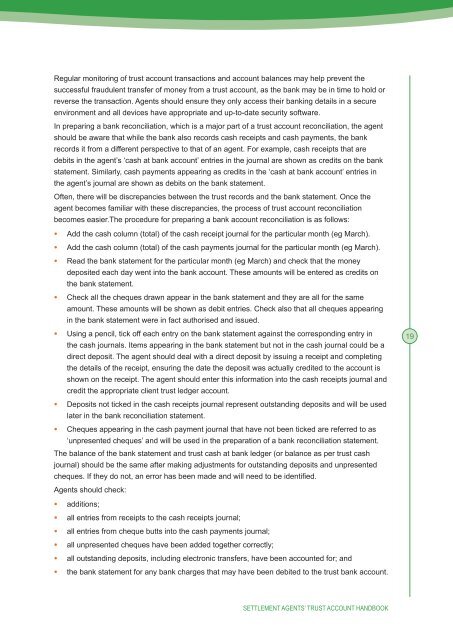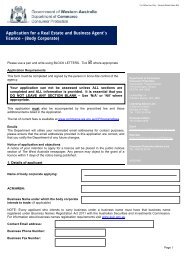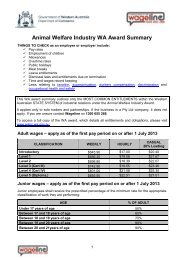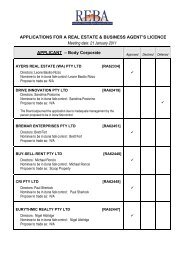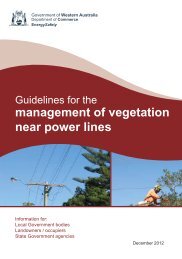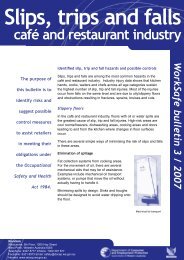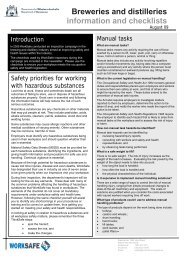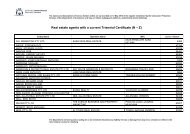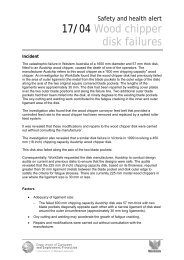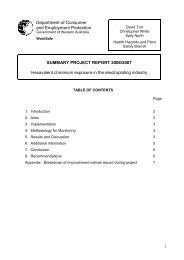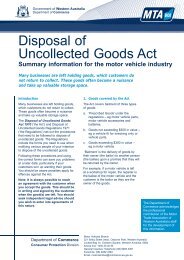Trust account handbook - Department of Commerce - wa.gov.au
Trust account handbook - Department of Commerce - wa.gov.au
Trust account handbook - Department of Commerce - wa.gov.au
You also want an ePaper? Increase the reach of your titles
YUMPU automatically turns print PDFs into web optimized ePapers that Google loves.
Regular monitoring <strong>of</strong> trust <strong>account</strong> transactions and <strong>account</strong> balances may help prevent the<br />
successful fr<strong>au</strong>dulent transfer <strong>of</strong> money from a trust <strong>account</strong>, as the bank may be in time to hold or<br />
reverse the transaction. Agents should ensure they only access their banking details in a secure<br />
environment and all devices have appropriate and up-to-date security s<strong>of</strong>t<strong>wa</strong>re.<br />
In preparing a bank reconciliation, which is a major part <strong>of</strong> a trust <strong>account</strong> reconciliation, the agent<br />
should be a<strong>wa</strong>re that while the bank also records cash receipts and cash payments, the bank<br />
records it from a different perspective to that <strong>of</strong> an agent. For example, cash receipts that are<br />
debits in the agent’s ‘cash at bank <strong>account</strong>’ entries in the journal are shown as credits on the bank<br />
statement. Similarly, cash payments appearing as credits in the ‘cash at bank <strong>account</strong>’ entries in<br />
the agent’s journal are shown as debits on the bank statement.<br />
Often, there will be discrepancies between the trust records and the bank statement. Once the<br />
agent becomes familiar with these discrepancies, the process <strong>of</strong> trust <strong>account</strong> reconciliation<br />
becomes easier.The procedure for preparing a bank <strong>account</strong> reconciliation is as follows:<br />
• Add the cash column (total) <strong>of</strong> the cash receipt journal for the particular month (eg March).<br />
• Add the cash column (total) <strong>of</strong> the cash payments journal for the particular month (eg March).<br />
• Read the bank statement for the particular month (eg March) and check that the money<br />
deposited each day went into the bank <strong>account</strong>. These amounts will be entered as credits on<br />
the bank statement.<br />
• Check all the cheques drawn appear in the bank statement and they are all for the same<br />
amount. These amounts will be shown as debit entries. Check also that all cheques appearing<br />
in the bank statement were in fact <strong>au</strong>thorised and issued.<br />
• Using a pencil, tick <strong>of</strong>f each entry on the bank statement against the corresponding entry in<br />
the cash journals. Items appearing in the bank statement but not in the cash journal could be a<br />
direct deposit. The agent should deal with a direct deposit by issuing a receipt and completing<br />
the details <strong>of</strong> the receipt, ensuring the date the deposit <strong>wa</strong>s actually credited to the <strong>account</strong> is<br />
shown on the receipt. The agent should enter this information into the cash receipts journal and<br />
credit the appropriate client trust ledger <strong>account</strong>.<br />
• Deposits not ticked in the cash receipts journal represent outstanding deposits and will be used<br />
later in the bank reconciliation statement.<br />
• Cheques appearing in the cash payment journal that have not been ticked are referred to as<br />
‘unpresented cheques’ and will be used in the preparation <strong>of</strong> a bank reconciliation statement.<br />
The balance <strong>of</strong> the bank statement and trust cash at bank ledger (or balance as per trust cash<br />
journal) should be the same after making adjustments for outstanding deposits and unpresented<br />
cheques. If they do not, an error has been made and will need to be identified.<br />
Agents should check:<br />
19<br />
• additions;<br />
• all entries from receipts to the cash receipts journal;<br />
• all entries from cheque butts into the cash payments journal;<br />
• all unpresented cheques have been added together correctly;<br />
• all outstanding deposits, including electronic transfers, have been <strong>account</strong>ed for; and<br />
• the bank statement for any bank charges that may have been debited to the trust bank <strong>account</strong>.<br />
SETTLEMENT AGENTS’ TRUST ACCOUNT HANDBOOK


